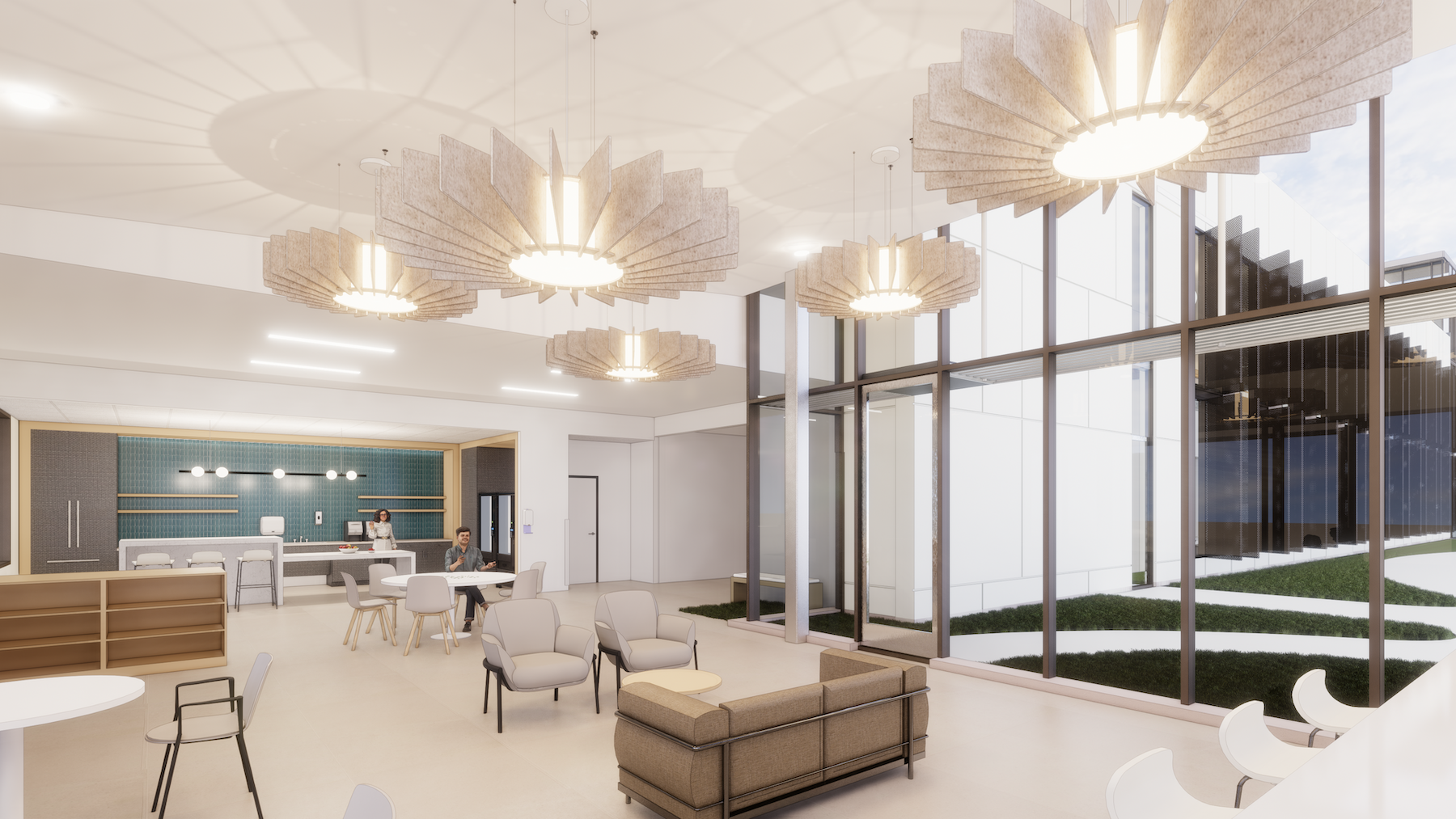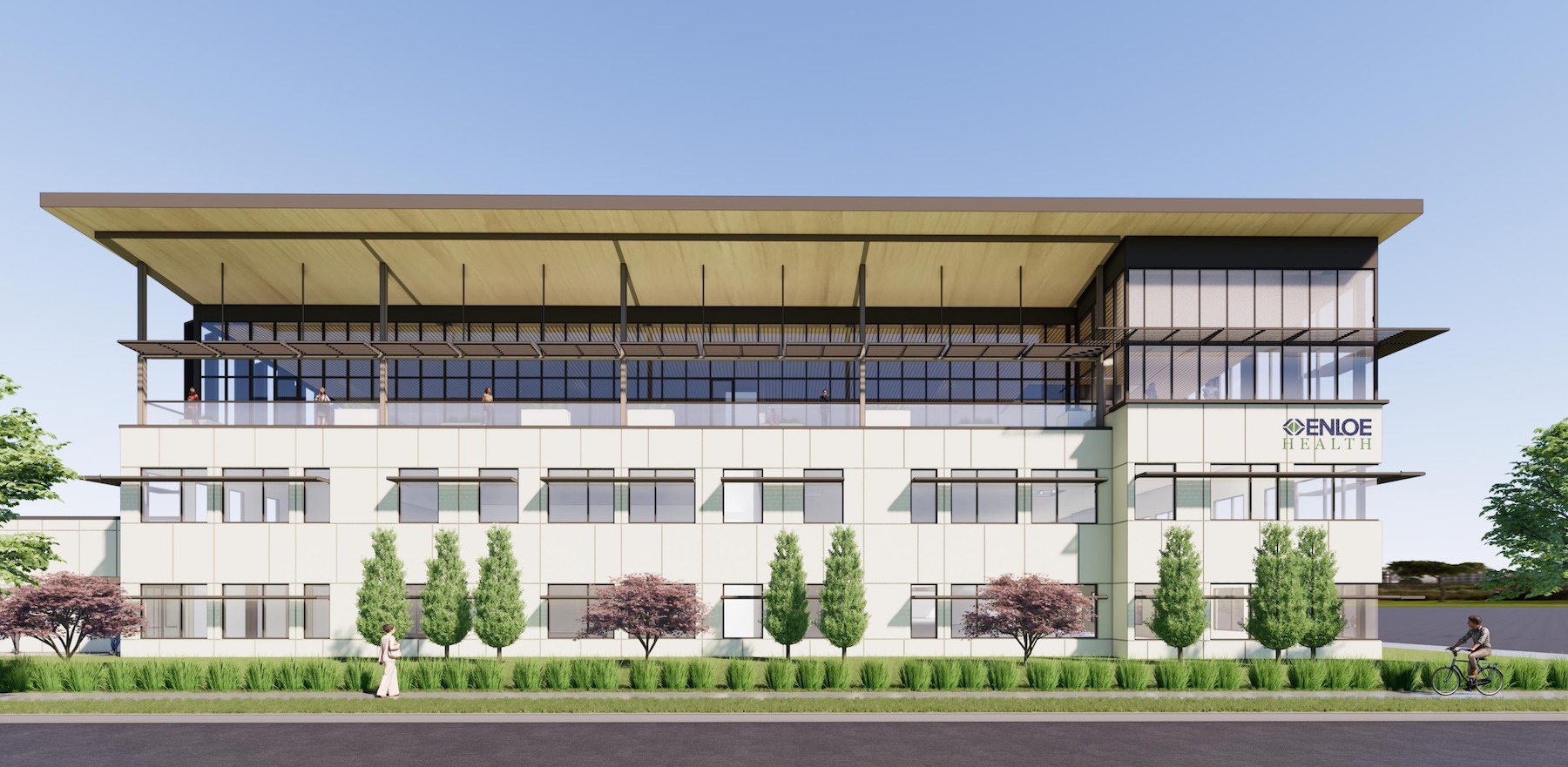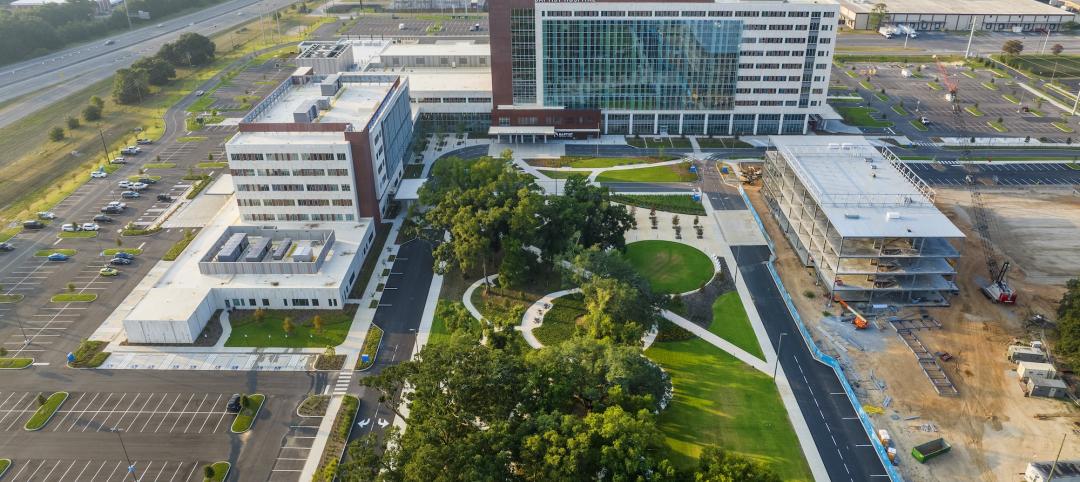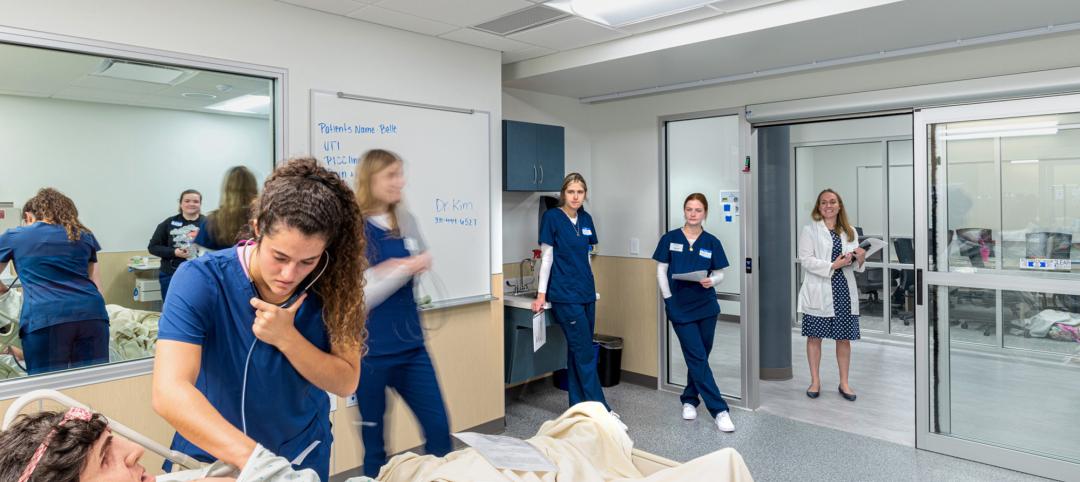Design-build and, to a somewhat lesser degree, Integrated Project Delivery (IPD) have become increasingly popular and common contract platforms for healthcare projects. These agreements promise greater efficiency and share the profit risk on new construction among developers, health systems, and AEC firms.
Add to that list of options Collaborative Project Delivery (CPD), which Covalus—a Dallas-based healthcare project management consultant that has pioneered this contractual initiative—says simplifies IPD in ways that make it more attractive to participants without sacrificing IPD’s benefits.
Also see: Healthcare construction costs for 2024
Covalus claims that CPD has been applied to more than $3 billion in healthcare projects. One of these is Enloe Health’s Comprehensive Cancer Center, a 107,000-sf outpatient building on 13 acres in Chico, Calif. This three-story project, valued at $154 million, broke ground this month, and is scheduled for completion in Spring of 2026.
According to this project’s general contractor Swinerton, CPD is different from other contractual agreements in that it allows team members to contribute a specific fee that they can earn back by achieving agreed-upon performance thresholds. “This simplified form of agreement eliminates the need for complex, multiparty legal and insurance mechanisms,” said Swinerton in a prepared statement.
Separate contracts, bridged together
Enloe Health’s previous experiences with projects under conventional design-bid-build contracts had left a bad taste in its mouth because those contracts opened the door for change orders that impacted negatively on the project’s cost, explained Kevin Woodward, Enloe Health’s chief financial officer.
There was also some urgency in finding the right project manager for its proposed Comprehensive Cancer Center. The region that encompasses Chico has one of the highest rates of cancer-related deaths in California. However, said Woodward, 60 percent of the region’s cancer patient population was bypassing Enloe Health’s facilities because they didn’t have the care capacity to handle that level of patient volume.
Enloe Health worked with ECG Management Consultants, a division of Siemens Healthineers, to conduct a space analysis to determine the size and prospective cost of a new CCC. After its board signed off on the facility, Enloe partnered with Covalus, which Woodward said had more-refined costing tools, and a track record with project management under CPDs.
By that time, HGA was already attached as the project’s design-architect. James Willsie, Principal and Associate Vice President with HGA, explained in an email to BD+C how CPDs differ from other delivery contracts:
“Typically with design building, there is one contract between the owner and the contractor, with the design team as a sub. With IPD, typically there is a three-way contract [among] the owner, contractor, and architect, with a target cost and schedule. There is profit at risk for the contractor, architect, and typically further downstream [for] consultants and subs, [which] becomes a project contingency.”
For a CPD, on the other hand, says Willsie, “the owner has a contract directly with the architect, a separate contract directly with the contractor, and a contract directly with the owner’s representative. There is also a multiple-party contract among all four parties that sets up profit at risk and enhanced profit put up by the owner.” The profit at risk and incentive pool are distributed upon meeting prearranged targets for schedules, budget, and a regularly administered feedback survey of the owner. The incentive pool is pushed through to key consultants and subcontractors, says Willsie.
Additional collaborators on the Enloe Health project include Buehler Engineering (SE), ECOM Engineering (electrical and low voltage engineering), Weston & Associates (M/P engineering), Criterion (medical equipment planning), NorthStar (CE), and Marquis (security).
Similar to design-build and IPD, CPD utilizes big room meetings, Target Value Delivery, RO logs, and other lean delivery principles, says Willsie.

Cost predictability a goal
Any level of contractual collaboration requires give and take from all participants. That includes a strategic vetting of partners for purposes of compatibility; early engagement of project team members to define objectives and goals, as well as performance parameters; and ongoing communication among all stakeholders, according to a December 31, 2022 posting by AIA Contract Documents, which are the starting points for Covalus’ CPDs.
During the design process for Enloe Health’s new cancer center, HGA’s Design Insight Group used research and benchmarking to cross-check and validate decisions. Enloe provided data to modify designs and determine how they might improve space programming. “The data we review is critical to achieving operational efficiency and treatment outcomes while improving the experiences of patients, physicians, and medical support staff alike,” said Jennifer Ries, HGA’s Senior Medical Planner, in a statement posted on the firm’s website.
In an interview with BD+C, Mark Chenoweth, Founder and Principal of Covalus, said that his firm started using CPD contracts about seven or eight years ago. He explained that CPDs combine the benefits and efficiencies of IPDs with traditional delivery methods. “CPDs preserve traditional contractual arrangements, and the contracts are tied together by bridge agreements,” Chenoweth elaborated. He added that CPDs stipulate a guaranteed maximum price for a project, which IPDs do not. (The GMP for Enloe Health’s project will be nailed down on June 1, said Woodward.)
Chenoweth said that owner expectations of CPDs revolve around cost predictability, value, speed to market, and team performance.
“CPDs set realistic value for the work and process,” said Chris Morris, Vice President-National Healthcare at Swinerton, for which the Enloe Health project is its first under an CPD contract. “If you have a good roadmap, the team feels success.” Morris said that one of the goals for these incentives-based team collaborations is to avoid “non-rewarding” work, like value engineering.
Concise construction management
Chenoweth explained that the fee that contractual partners pay as part of the contract is a percentage of the cost of work and a portion of the minimum amount of the profit at risk; a kind of buy-in, he agreed. For the Enloe Health project, every firm under the CPD contract will receive at least 1.5 percent of their overhead. (That percentage, said Woodward, is one-third of the profit-at-risk for the contract’s participants. In Swinerton’s case, the 1.5 percent is equivalent to about $250,000, he said.)
Woodward, whom BD+C interviewed yesterday, said that Enloe Health has been satisfied with the results from the CPD. “It’s been a great project, and we’re right on track.” Woodward has been particularly impressed with the problem solving in big room meetings, Covalus’ representation on behalf of the owner, as well as with the “visibility” that Enloe has had into the bids from all of the trades.
The new Comprehensive Cancer Center in Chico will include three linear accelerator vaults and a 56-bay infusion center, according to Jolene Francis, Enloe Health’s Vice President of Philanthropy and Communications. Enloe expects the new center to create between 75 and 100 permanent jobs.
Chenoweth said that Covalus is managing other healthcare projects under CPD contracts in the Midwest and East Coast, and is talking with six other health systems. Morris speculated that healthcare sector has been amenable to these kinds of contracts because they “add structure to a complicated business that is ripe for change. CPDs are more concise and consistent.”
Related Stories
Healthcare Facilities | Jan 7, 2024
Two new projects could be economic catalysts for a central New Jersey city
A Cancer Center and Innovation district are under construction and expected to start opening in 2025 in New Brunswick.
Designers | Jan 3, 2024
Designing better built environments for a neurodiverse world
For most of human history, design has mostly considered “typical users” who are fully able-bodied without clinical or emotional disabilities. The problem with this approach is that it offers a limited perspective on how space can positively or negatively influence someone based on their physical, mental, and sensory abilities.
Healthcare Facilities | Dec 19, 2023
A new hospital in Duluth, Minn., is now the region’s largest healthcare facility
In Duluth, Minn., the new St. Mary’s Medical Center, designed by EwingCole, is now the largest healthcare facility in the region. The hospital consolidates Essentia Health’s healthcare services under one roof. At about 1 million sf spanning two city blocks, St. Mary’s overlooks Lake Superior, providing views on almost every floor of the world’s largest freshwater lake.
Healthcare Facilities | Dec 7, 2023
New $650 million Baptist Health Care complex opens in Pensacola
Baptist Health Care’s new $650 million healthcare complex opened recently in Pensacola, Fla. Featuring a 10-story, 268-bed hospital, the project “represents the single-largest investment in the healthcare history of northwest Florida,” said Gresham Smith project executive Robert “Skip” Yauger, AIA, LEED AP. The 602,000 sf Baptist Hospital is equipped with a Level II trauma center that provides 61 exam rooms and three triage areas.
Engineers | Nov 27, 2023
Kimley-Horn eliminates the guesswork of electric vehicle charger site selection
Private businesses and governments can now choose their new electric vehicle (EV) charger locations with data-driven precision. Kimley-Horn, the national engineering, planning, and design consulting firm, today launched TREDLite EV, a cloud-based tool that helps organizations develop and optimize their EV charger deployment strategies based on the organization’s unique priorities.
Healthcare Facilities | Nov 3, 2023
The University of Chicago Medicine is building its city’s first freestanding cancer center with inpatient and outpatient services
The University of Chicago Medicine (UChicago Medicine) is building Chicago’s first freestanding cancer center with inpatient and outpatient services. Aiming to bridge longstanding health disparities on Chicago’s South Side, the $815 million project will consolidate care and about 200 team members currently spread across at least five buildings. The new facility, which broke ground in September, is expected to open to patients in spring 2027.
Sponsored | | Oct 17, 2023
The Evolution of Medical Facility Security
As the healthcare system grows, securing these facilities becomes ever more challenging. Increasingly, medical providers have multiple facilities within their networks, making traditional keying systems and credentialing impractical.
Healthcare Facilities | Oct 11, 2023
Leveraging land and light to enhance patient care
GBBN interior designer Kristin Greeley shares insights from the firm's latest project: a cancer center in Santa Fe, N.M.
Healthcare Facilities | Oct 9, 2023
Design solutions for mental health as a secondary diagnosis
Rachel Vedder, RA, LEED AP, Senior Architect, Design Collaborative, shares two design solutions for hospitals treating behavioral health patients.
Giants 400 | Oct 5, 2023
Top 115 Healthcare Construction Firms for 2023
Turner Construction, Brasfield & Gorrie, JE Dunn Construction, DPR Construction, and McCarthy Holdings top BD+C's ranking of the nation's largest healthcare sector contractors and construction management (CM) firms for 2023, as reported in Building Design+Construction's 2023 Giants 400 Report. Note: This ranking includes revenue related to all healthcare buildings work, including hospitals, medical office buildings, and outpatient facilities.

















